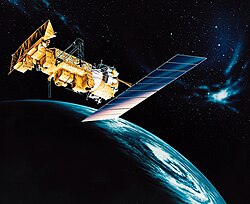Mission
TIROS 10 was a Sun-synchronous meteorological spacecraft designed to develop improved capabilities for obtaining and using TV cloud cover pictures from satellites and operated as an interim operational satellite. The spin-stabilized spacecraft was in the form of an 18-sided right prism, 107 cm across opposite corners and 56 cm high, with a reinforced baseplate carrying most of the subsystems and a cover assembly. Electric energy was supplied to the spacecraft by approximately 9000 1-by 2-cm silicon solar cells that were mounted on the cover assembly and by 21 nickel-cadmium batteries. A single monopole antenna for reception of ground commands extended from the top of the cover assembly.
A pair of crossed-dipole telemetry antennas (235 MHz) projected down and diagonally out from the baseplate. Mounted around the edge of the baseplate were five diametrically opposed pairs of small solid-fuel thrusters that maintained the satellite spin rate between 8 and 12 rpm. Proper attitude was maintained to within a 1° to 2° accuracy by use of a magnetic control device consisting of 250 coils of wire wound around the outer surface of the spacecraft. The interaction by the induced magnetic field in the spacecraft and the Earth's magnetic field provided the torque necessary for attitude control.
The satellite spin axis could thus be varied while the satellite remained in the conventional TIROS "axial" mode. The satellite was equipped with two identical wide-angle TV cameras with 1.27-cm vidicon for taking earth cloudcover pictures. The pictures could be transmitted directly to either of two ground receiving stations or stored in a tape recorder on board for subsequent playback if the spacecraft was beyond the communication range of the station.
The satellite was launched into a near-polar orbit and successfully provided TV coverage of the entire daylight portion of the Earth. The TV system operated normally until September 30, 1965, and sporadically through July 31, 1966, when the spacecraft was deactivated. [3]
This page is based on this
Wikipedia article Text is available under the
CC BY-SA 4.0 license; additional terms may apply.
Images, videos and audio are available under their respective licenses.

